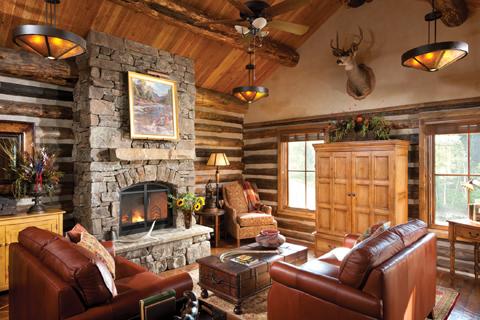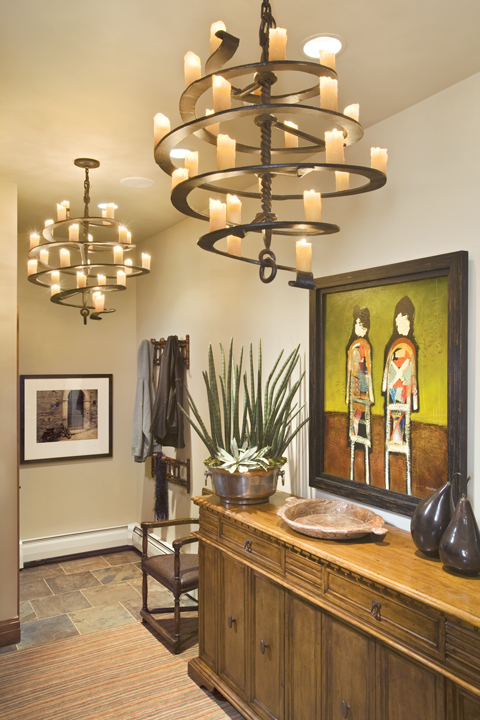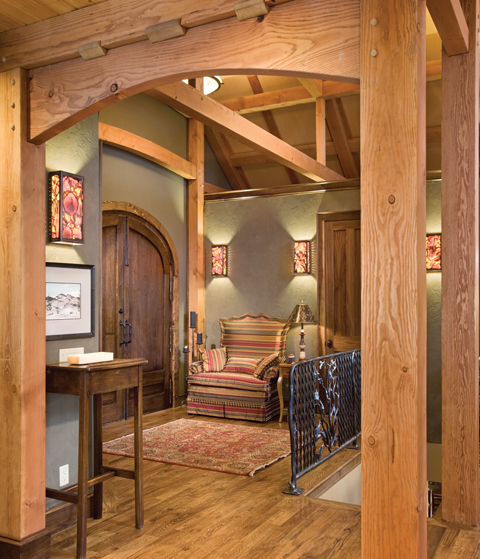Warm reading light in a cozy den, bright task light over kitchen counters, strategically placed walkway lights along a garden path: lighting is one area of your home where having the right plan in place can make all the difference.
One of the things we love about log and timber homes is the way the designs showcase the natural beauty of wood. Properly planned lighting design can help highlight, not hide, that beauty. “Lighting should not dictate the architectural design, but you wouldn’t want to miss opportunities for dramatic effect by waiting too late in the process,” says Allen Holcomb, president of MossCreek in Knoxville, Tennessee.
Lighting can be categorized by use: general (or ambient), task, and dramatic lighting. General lighting is a way to light up a room overall and should be designed so that a room is neither too light nor too dark. Task lighting is what you use to brighten up a kitchen work space or desk. Dramatic light is used to accent and enhance the architecture of the home. It may include floor lights that shine up on posts or draw attention to a fireplace, sconce lighting, and lights that showcase artwork.

Photo by Heidi Long
Keep your home’s overall design and feel in mind when planning for lighting. Log and timber frame homes need particular care because they can feel dark. “Darkly stained wood surfaces absorb dramatic amounts of light, as opposed to painted surfaces in traditional homes,” explains Holcomb. “It is hard to overilluminate log and timber homes, but we recommend putting all lighting on dimmers so that it can be taken up or down not only to get the right mix overall, but also to get the right balance during evening hours versus daylight hours.”
Holcomb advises that it is better to spread lighting evenly around the home to avoid dark corners and overly lit areas. “Another consideration,” he says, “is to pin down a fixture style that suits you and your home well. If that style is Craftsman, stay with that style throughout the house. If the style is modern, or Italian, or cabin, stick with the same style throughout the house.” A departure from that style in a room or two is fine, but overall the home should reflect a cohesive theme.

Photo by Roger Wade
The same design rules apply to exterior lighting as well. You want to complement your property and outdoor living spaces, not detract from them. In general, exterior lights should be subtle and blend with your landscaping and hardscape design, but there’s always room for a dramatic uplight on an accent plant or lights that draw attention to a water feature. Don’t forget lighting up pathways and doors, for safety.
It helps to have an expert weigh in, so don’t be afraid to ask for help. “On modest homes, it’s typical for the builder to work directly with the homeowner to come to decisions that make both financial and functional sense,” says Holcomb. “On more expensive and specifically designed homes, the best choice is to work with a design professional to determine the types of lighting and locations that create not only a functional solution, but a beautiful and dramatic solution.” Once you have a plan in place, you can work with your builder and lighting supply company to come up with fixtures that fit within your budget.
Think outside of the box if you can’t find just the right light. MossCreek is currently working on a home in New York with a large great room and a fireplace that features overscaled stone. “We’ve been working with a local blacksmith to create the perfect chandelier design,” says Holcomb, as they were unable to find a chandelier that met the room’s needs and looked just right.
LED lights have been a game-changer in many ways, for both interior and exterior lighting. There are plaster-in lights for a subtle glow, tiny lights that allow you to light very specific spaces, and “smart” bulbs that can be controlled from your phone. There are more uses of LED on the market every day.

Tynecastle Builders/photo by Roger Wade
Lighting your home the right way can be a major investment, but there are ways to save on costs without compromising quality:
• Plan ahead: it is harder and more costly to make changes to lighting design after your home is built.
• Buy basic light needs at discount or “big box” stores, but invest a little more on a few key lighting fixtures.
• Computerized light controls may cost more up front but can save energy (and money) down the road.
• Use LEDs instead of incandescent bulbs; they are at least 75% more
efficient and last 25 times longer.
• Consider using solar lights for exterior areas to save even more on
energy costs.
With lighting, more is not necessarily better, even in a log or timber frame home, which may feel dark during the short days of winter. Going through your house room by room at the design stage to plan the right light for the space based on how you’ll be using it is essential—for aesthetics, comfort, efficiency and cost savings.

